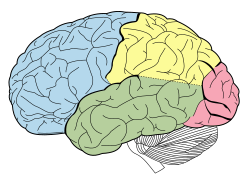Discrete emotion theory is the claim that there is a small number of core emotions. For example, Silvan Tomkins (1962, 1963) concluded that there are nine...
8 KB (902 words) - 22:37, 10 August 2024
The theory of constructed emotion (formerly the conceptual act model of emotion) is a theory in affective science proposed by Lisa Feldman Barrett to explain...
11 KB (1,374 words) - 00:07, 7 February 2024
discrete emotion theory, all humans are thought to have an innate set of basic emotions that are cross-culturally recognizable. These basic emotions are...
56 KB (4,646 words) - 04:04, 4 May 2025
on how emotions occur. Discrete emotion theory takes a categorical approach, suggesting there is a universal set of distinct, basic emotions that have...
47 KB (5,745 words) - 07:04, 9 May 2025
stressors). Emotion Generation: The theory suggests that these affective events generate emotions in employees. These emotions can be either discrete (specific...
138 KB (16,263 words) - 00:17, 10 May 2025
theory is a theory that seeks to organize affects, sometimes used interchangeably with emotions or subjectively experienced feelings, into discrete categories...
18 KB (2,185 words) - 16:56, 13 February 2025
brain. The theory emphasises on the discrete emotions along with five assumptions (one: the fundamental emotions; two: the fundamental emotions each have...
13 KB (1,619 words) - 12:24, 28 November 2024
Appraisal theory is the theory in psychology that emotions are extracted from our evaluations (appraisals or estimates) of events that cause specific reactions...
41 KB (5,778 words) - 18:19, 7 April 2024
existence of discrete emotions such as fear and joy are one of many theoretical approaches to understanding the ontological nature of emotions. Historically...
26 KB (2,775 words) - 22:33, 9 May 2025
The James–Lange theory (1964) is a hypothesis on the origin and nature of emotions and is one of the earliest theories of emotion within modern psychology...
22 KB (3,019 words) - 19:54, 5 March 2025
emotion or argumentum ad passiones (meaning the same in Latin) is an informal fallacy characterized by the manipulation of the recipient's emotions in...
28 KB (3,820 words) - 04:51, 18 January 2025
various psychotherapeutic procedures. A symbolic verbal code includes discrete words and subsequently images embedded in the language and is processed...
7 KB (859 words) - 21:01, 7 February 2025
Paul Ekman (category Emotion psychologists)
language Discrete emotion theory § Criticism Emotional granularity Emotions and culture Emotion classification Origin of language Origin of speech Theory of...
36 KB (4,165 words) - 10:58, 8 May 2025
Psychologist Paul Ekman supported the discrete emotion perspective with his groundbreaking work comparing emotion perception and expression between literate...
47 KB (5,711 words) - 05:32, 11 November 2024
Carroll Izard (category Emotion psychologists)
Children: Vol. 1. (1982). Cambridge University Press. Discrete emotion theory Basic emotions Emotion classification Manser, Ann (2017-02-13). "In Memoriam:...
9 KB (997 words) - 23:25, 20 July 2023
While the topic of emotions can be found in early classic sociological theories, sociologists began a more systematic study of emotions in the 1970s when...
25 KB (3,044 words) - 03:20, 28 December 2024
mechanisms have been suggested as mediators of emotion effects on memory: Easterbrook's (1959) cue utilization theory predicted that high levels of arousal will...
60 KB (7,087 words) - 21:31, 31 January 2025
identifying emotions and tracing their influences on decision-making. Emotional choice theory is considered an alternative model to rational choice theory and...
21 KB (2,711 words) - 08:04, 4 May 2025
intentional behavior as well as the expression of emotions. The theory says that children use their own emotions to predict what others will do; we project our...
17 KB (2,198 words) - 05:01, 3 December 2023
Arousal (category Emotions)
cycle). It holds significance within emotion and has been included in theories such as the James–Lange theory of emotion. According to Hans Eysenck, differences...
51 KB (6,759 words) - 03:57, 9 May 2025
Emotion recognition is the process of identifying human emotion. People vary widely in their accuracy at recognizing the emotions of others. Use of technology...
34 KB (3,707 words) - 03:02, 26 February 2025
common to define an attitude as affect toward an object, affect (i.e., discrete emotions or overall arousal) is generally understood as an evaluative structure...
54 KB (6,323 words) - 09:53, 10 April 2025
phenomena such as moral emotions, trust and ethical leadership. RMT has been influential in the development of Steven Pinker's theory of indirect speech,...
18 KB (1,939 words) - 00:24, 28 November 2023
Silvan Tomkins (section Affect theory)
New York: Springer. Discrete emotion theory Cook, Joan (June 14, 1991). "Silvan Tomkins, 80, Psychologist Who Cited Power of Emotion, Dies". The New York...
63 KB (8,661 words) - 17:42, 3 May 2025
others' beliefs, desires, intentions, emotions, and thoughts may be different from one's own. Possessing a functional theory of mind is crucial for success in...
136 KB (17,082 words) - 03:55, 9 May 2025
Neuroticism (category Emotion)
in negative emotion, they are not necessarily high in positive emotion. According to a 1998 study, being high in scores of positive emotion is generally...
45 KB (5,498 words) - 06:23, 26 April 2025
Affective computing (redirect from Emotion AI)
describe her concept of emotion as "objective, internal, private, and mechanistic". They say it reduces emotion to a discrete psychological signal occurring...
55 KB (6,396 words) - 10:01, 6 March 2025
Dacher Keltner (section Human emotion)
that each emotion category has many variations within it, and that discrete emotion concepts (e.g., “awe” “sympathy”) rather than broader constructs such...
20 KB (2,038 words) - 23:44, 15 March 2025
usually based on the basic emotions theory (by Paul Ekman) which assumes the existence of six discrete basic emotions (anger, fear, disgust, surprise, joy...
13 KB (893 words) - 23:57, 30 March 2025
that among these primary neural systems are at least three discrete, interrelated emotion-motivation systems in the mammalian brain for mating, reproduction...
33 KB (3,784 words) - 14:43, 11 April 2025










